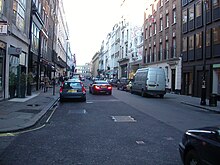Albemarle Street

Albemarle Street is a street in
History

Albemarle Street was built by a syndicate of developers headed by
Albemarle Street was the first
Notable residents
This section needs additional citations for verification. (February 2024) |
Robert Harley, 1st Earl of Oxford and Earl Mortimer (1661–1724), a leading minister of Queen Anne, had a house in Albemarle Street where he died in 1724.
Victor Spencer, 1st Viscount Churchill (1864–1934), a Page of Honour to Queen Victoria and British peer, was born at 32 Albemarle Street.
Anne Lister (1791–1840), a notable early 19th-century lesbian, stayed at 29 Albemarle Street in rooms owned by Hawkins, who also had premises in Dover Street. In June 1834 Anne Lister stayed at number 13 with her wife Ann Walker (1803–1854).[2]
The Albemarle Club was originally in Albemarle Street and relocated to Dover Street nearby before its closure. Oscar Wilde was a member. In 1895, the Marquess of Queensberry left his calling card for Wilde with the infamous note "For Oscar Wilde, posing as a somdomite" [sic]. This led to Wilde's failed libel action and subsequent criminal prosecution.
The publisher
Captain O.M.WATTS, at 49 Albemarle Street was once the large showroom and mail order department of O. M. Watts a master mariner and nautical author who founded and ran his ship chandlers and yacht brokerage until his death in 1985.
Frenchman Alexander Grillion opened Grillion's Hotel at No. 7 in 1803.

The
The naturalist
Rev. William Webb Ellis (1806–1872) was an Anglican clergyman who is famous for allegedly being the inventor of Rugby football whilst a pupil at Rugby School. He graduated from Oxford with a BA in 1829 and received his MA in 1831. He entered the Church and became chaplain of St George's Chapel, Albemarle Street, London (c. 1800–1903). Here he published his Sermons: Preached in St. George's Chapel, Albemarle Street; to Which Is Added, an Essay On the Prophecies Relative to Christ. The Chapel was built on instructions of Lord Suffield who lived on Albemarle Street and leased land at number 27 on which at some time between 1800 and 1811 a proprietary chapel, St George's, was built (demolished in the early twentieth century).[5]
The Beaux-Arts building, the Mellier, at 26b Albemarle Street originally the home and showroom of Charles Mellier & Co. Mellier was born in France and became a successful high quality cabinet maker and decorator; one of his most famous commissions was for the liner RMS Mauretania.
In 1921
In the 1950s, Ernő Goldfinger's design for two office buildings at 45–46 Albemarle Street was praised for its sensitivity to the surrounding Georgian architecture.[6]
The private member's club Oswald's is based in a town house at 25 Albemarle Street.[7]
Galleries

The street is host to a number of art galleries. These include:
- Connaught Brown, 2 Albemarle Street
- The Archeus Gallery, 3 Albemarle Street
- Marlborough Fine Art, 6 Albemarle Street
- W. H. Patterson Fine Arts, 19 Albemarle Street – until 2012[8]
- Phillips de Pury & Company, 25–26 Albemarle Street[citation needed]
- Mazzoleni Art, 27 Albemarle Street – until 2022[9]
- The Grosvenor Gallery, 37 Albemarle Street[citation needed]
- John Martin of London, 38 Albemarle Street
- Gallery of African Art, 45 Albemarle Street[citation needed]
- The Albemarle Gallery, 49 Albemarle Street[citation needed]
- Faggionato Fine Arts, 49 Albemarle Street (first floor)[citation needed]
Location
To the south-east, the street adjoins
See also
References
- ISBN 978-0-7134-5449-9.
- ^ Anne Lister in London 1819-1839 Archived 13 August 2006 at the Wayback Machine
- ^ Geraldine Edith Mitton (1903). Mayfair, Belgravia, and Bayswater.
- ^ James, Frank. "Making traffic history – Albemarle Street". The Royal Institution of Great Britain. Archived from the original on 6 February 2013. Retrieved 30 December 2012.
- ^ William Webb Ellis (1838). Sermons preached in St. George's chapel, Albemarle street. To which is added, An essay on the prophecies relative to Christ. Rivington and Hatchard.
- ^ Ernő Goldfinger / Designing Modern Britain — Design Museum
- ^ "Members only: the rise of Mayfair's private clubs". The Times. 12 January 2022. Retrieved 10 May 2022.
- ^ "Our History". Gladwell & Patterson. Retrieved 22 October 2023.
- ^ "Mazzoleni Art : AGOSTINO BONALUMI. Shaped Metal". Mazzoleni Art. 4 February 2022.
